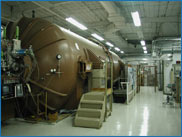|
|
||||
|
|
||||
 |
||||
|
How Old Is Lost City?- Carbon 14 Dating The question “How old are you?” is often one of the first questions that comes to mind when meeting someone. The same is true in science and other fields when encountering a new sample or unknown specimen. However, a fossil, rock, or gas will not answer the question “How old are you?” and so very careful analytical methods have been developed to place an age to these samples. If the sample contains carbon, and is not older than ~40,000 years, it can be dated very accurately using a technique known as “carbon-14 dating” or “radiocarbon dating”.
One method to accurately count carbon-14 atoms is called accelerator mass spectrometry (AMS). This method utilizes a huge spectrometer, an instrument the size of ten large classrooms that consists of a source, an accelerator and various detectors. There are not very many laboratories that make AMS measurements. For this project we have used one of the best AMS facilities, Lawrence Livermore National Laboratory’s Center for Accelerator Mass Spectrometry. Basically, what the instrument does is accelerate a beam of carbon ions to very high energies. At high energy the carbon ion beam can be manipulated using large magnets so that the various isotopes (12C and 14C) get directed towards different detectors. Furthermore, high energies are required for the detector that counts the carbon-14 atoms to work properly. Every sample requires a few hours of preparation, about 10 minutes for the instrument to measure, and $300+ in instrument costs. http://www.c14dating.com/ |
||||
